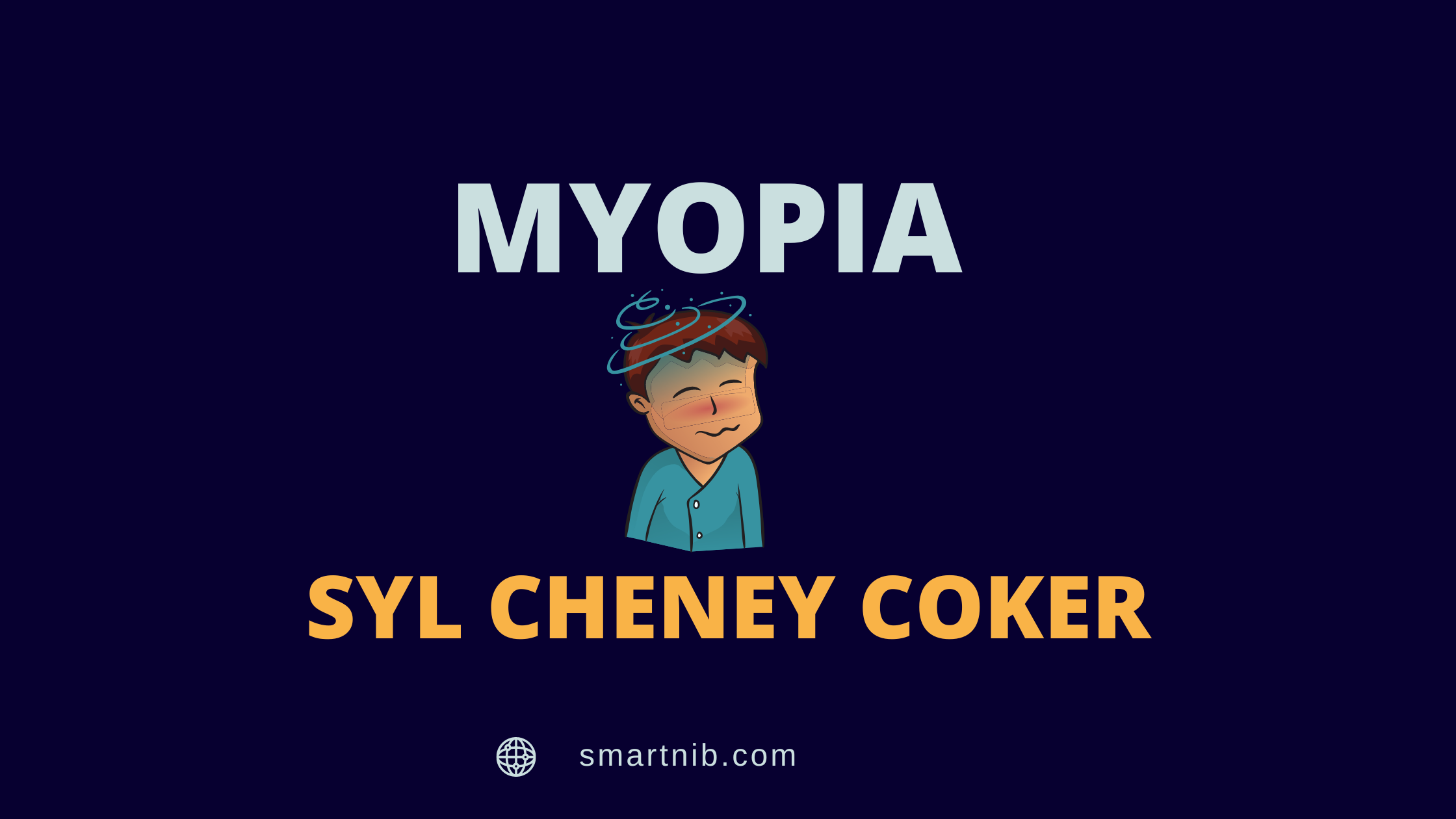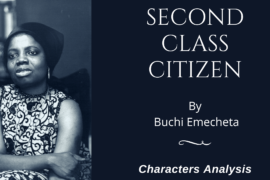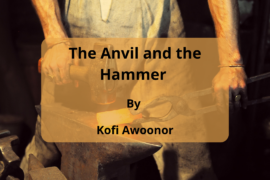This article contains the analysis of Myopia by Syl Cheney Coker; the Background of the poem, the setting, the subject matter, summary, themes, language and style, the structure, and the biography of Syl Cheney Coker.
Background
With independence in 1961, sierra Leoneans, like Africans in other newly-independent nations across the continent, looked forward to the realization of the dreams of an egalitarian and prosperous nation. Shortly after independence, they became disillusioned. Steadily, things moved from bad to worse as dictatorship took over the reins of governance.
The atmosphere in the country became characterized by oppression, repression, intimidation, and fear, especially during president Siaka Steven’s years as the country’s leader. Not only this, the socioeconomic condition of Sierra Leoneans, especially the masses, became more terrible. Forced by environmental degradation due to mining activities, farmers in the hinterland also moved to the urban areas, especially the capital city, Freetown, in search of a non-existent better life.
Consequently, the number of city dwellers increased, joblessness increased, and social amenities deteriorated and the government could not respond positively and proactively to these challenges. Rather, the opulence and extravagance of the political class continued unabated. It is this scenario that motivated a poem like Syl Cheney’s ‘Myopia.’
Setting
The physical setting of the poem is an urban area with wide and well-laid-out streets, apparently Freetown in Sierra Leone. Temporally speaking, the poem is situated in the post-independence Sierra Leone of the 1970s and1980s.
Subject Matter/Summary
This poems Myopia by Syl Cheney Coker examines two issues. The first describes the plight of the non-privileged members of the poet’s society. It attempts to profiles the physical, social, and economic conditions of this class of people whom he describes as PEASANTS. The second aspect captures the poet’s feelings about the aforementioned terrible situation as well as his resolve to lead the vanguard of change.
Lines 1-4
In these lines, a portrait of the peasants, the poor majority, is presented. Either walking or working on the street of the country, these people have no shelter to protect them from inclement weather. Therefore whenever it rains they are drenched and consequently shiver with cold. Physically, they are also described as ’emaciated bones’, which suggests that they are unhealthy and skinny, apparently from the effect of malnutrition. The streets in which they are found are also described as ‘boulevards of misery’.
Lines 5-11
In this stanza, the poet describes the ugly sight of the street of his country as a cause of emotional torment in him, using the metaphor of railway tracks and trains. He also speaks of hunger in the land as a natural cause of anger in the people. This is because the rice fields in the country have become barren and infertile and there seems to be no kind of fertilizer that can turn the situation around. The poet finds the situation disgusting as he describes it as constituting a ‘ putrid marshland in my soul’.
Lines 12-21
These lines expound the poet’s resolve and strategies to effect a change in society. He expresses the wish to be at the forefront of the necessary changes in the country. He ask to be made the arrowhead of protest in the event of failed promises by the leadership of the country. He goes further to volunteer self as a key player even if the change has to be effected through a revolutionary approach. When he says ‘if madness we must have’, he is talking of a violent and bloody change. And, expresses the readiness to be in the lead ‘hanging myself’, and everybody necessary at the appointed time and also exposing the leadership’s betrayal of the masses.
Themes
a) Miserable Lives Of The Masses
A major preoccupation of the poem is the living conditions of the downtrodden of class of the people in the society, the class that constitutes the majority. The members of this class are described as homeless lot. Because they live on the streets, which are also described as ‘the boulevards of misery’, whenever it rains, these people are seen ‘drench’ and exposed to cold. To further underscore their misery, we are intimated of their physical appearance. They look as good as ’emaciated bones’. By this description, the poet draws attention to their extremely thin physical build which, no doubt, result from starvation, malnutrition, or illness. To corroborate this observation, he recalls the rage in the land which is the ‘corollary of hunger’. The cause of the hunger’ itself is traced to infertile and badly managed farmland in the country. Since the majority of African low class engages primarily in agriculture, this situation further aggravates the misery.
b) Bad Leadership
Another concern of the poem is bad Leadership in Africa. The leadership class in the poet’s country and, by extension, Africa is depicted as characterized by qualities antithetical to good governance. They give the people false promises, especially when they need their support to get into plum offices. No sooner do they get into position of power than their promises became ‘still born’. They abondon the masses to their misery as they neglect agriculture and show nococern for the welfare of the people. The farmland on which the peasants grow the staple food, rice, becomes barren and nothing is done about it. The peasants lack shelter and walk the streets of misery, yet the leaders are indifferent. Hunger’ and anger are thereby engendered in the society. Ultimately, the people’s trust and hope in the leadership are betrayed.
C) The Imperative of Revolutionary Changes
Against the foregoing, the poem also advances the need for revolutionary change in the society, with respect to the political class in particular, and elite in general. A most remarkable thing about this advocacy for change is the apparent readiness of the persona, ostensibly elite, to commit class and real suicides in the effort to effect the desired change. He is ready to be the sword of change when the time dawns, ready to become ‘the incendiary bomb’ when the falsity of the leaders’ promises are exposed, and ready to expose and condemn self and others’ betrayal of Masses. He is even ready to take himself and culpable others’ lives even if blood-letting and violence are the only things that can guarantee the needed change.
Language and style
Metaphor
A device of indirect comparison or knowledge transfer, the metaphor is effectively used in the poem. Within lines 5 and 7, two instances of metaphorical construction are noted. The poet describes the boulevards of his country as ‘railway track in my heart’s while going further to add that ‘A train of anguish runs on them’. Both metaphors have significant implications. The first implies that the planes of the poet’s or persona’s mind are filled with psychological misery equivalent to the material misery seen on the road streets of the country.
The second one corroborates the first in the sense that ‘A train of anguish’ which runs on them implies the emotional torments experienced by the persona. Indirectly, a parallel is also drawn between the person’s state of mind and the rice field of the country in lines 9 and 10 where we are informed that ‘the rice pads of this country/are putrid marshland in my soul’. Here the parallel is between the persona’s feeling of disgust about the development in the country and the disgusting sight of the barren and unproductive rice field in the country. The description of the masses as ’emaciated bones’ is a metaphor for their physical and health conditions.
Personification
It is a poetic device that gives qualities or attributes of human beings to a non-human entity. There is one instance of the use of this device in the poem as seen in the expression, ‘ if the skeleton of stillborn promises/dry up in the catacombs’ (ll.14and15). Here, promises are treated as if they are babies that are born dead.
Alliteration
This device of repeated use of the same consonant sound at initial position of nearby words is used to appeal to our sense of hearing as seen in expression ‘skeletons of stillborn (l.14) , ‘if madness we must (l.17)and ‘hangman myself'(l.28).
Assonance
This is a poetic device whereby similar vowel sounds are repeated in a line of poetry to create or enhance musicality. An example is observed in ‘blows tomorrow’ in line 12 of the poem.
Imagery
This refers to a sensitive use of choice. Words evoke mental pictures in the reader with a view to making him or her relate or respond to the experience of the poet or persona in the poem. Few such uses are observed in the poem. They include ‘drench’ (l.2) and ’emaciated bones'(l.3), which are used to objectify the pitiable conditions of the peasants. Other examples include ‘railway track’ (l.6) and ‘skeletons’ (l.14). There is also the imagery of disgust in the expression ‘putrid marshlands’ (l.10).
Repetition
To emphasize and draw attention to an he feels strongly about, the poet uses repetition with respect to the word ‘hang’. He actually uses the hanging three times and the word hangman once, both within lines 18and 19. This is to underscore the person’s readiness to go bloody in the effort to effect the needed change.
Parallelism
This device, which involves a structural balance or parallel between two or more expressions, is used in line 20 of the poem where we have ‘not by its neck not by its belly’. This is significant for drawing attention to how the poet intends to carry out his self-imposed hanging assignment.
Tone
The tone of the poem is sympathetic, angry and resolute; sympathetic towards the masses; angry at the leaders and the elite who have brought untold misery on the masses and resolute in it’s determination to effect a change.
Structure
The poem is made of twenty-one lines, divided into three stanzas of unequal lines. Comprising four lines, the first stanza gives a portrait of the downtrodden segment of the society with attention to their physical and socioeconomic condition. Stanza two, which consists of seven lines, captures the feelings of the poet towards this condition while the third stanza, the longest and comprising ten lines, focuses on the persona’s resolve to bring about change. The poem is written in blank verse with no rhyme at the end of the lines. Each of the stanza is devoted to different but interrelated concerns. A sizeable number of the lines also run into one another.
A detailed account of the poem and comment on it tone
The poem begins with a portrayal of the masses in the society focused on. These people are depicted as poor and homeless people who get beaten by the rain whenever it falls. This is probably because they lack shelter and live on the streets. The description further shows that they are unhealthy and starving as we see them ‘ Along the boulevard if misery in ’emaciated bones’. On the whole, we have a picture of terrible improvised people.
In the second segment of the poem, which is the second stanza, the poem focuses on the persona’s attitude towards the situation in his land. He views the situation as condemnable and as a cause of emotional torment for concerned individuals like him. He also talks of hunger in the land, which he also singles out as the cause of anger and disaffection in the country.
The state of agriculture, especially rice production in the country is talked about. There is the suggestion that rice production has seen better days in the country since the farmland has become so infertile that ‘no magic fertilizer’ can make it yield the desired harvest. Again, the poet shows disgust for this state of affairs by metaphorically likening the farmland to the ‘putrid marshlands in my soul’.
In the last section of the poem, we see the poet’s determination and strategies to bring about change in his society. In different ways, he expresses his interest in being involved in the steps that would lead to change in society. He shows the readiness to lead to a vanguard of change as he demands: ‘make me a saber of that wind’, ‘make me the incendiary bomb or ‘let me be the hangman hanging myself/hanging them hanging the day. By these demands, he advocates a revolution change if peaceful change is made impossible.
In the poem, three times are easily discernible, those of sympathy, anger, and determination. The poet is particularly enraged by the state of affairs in his country, especially by the treatment given to the non-privileged members of society. While he sounds condemnatory of the situation, he also sounds sympathetic to the plight of the masses that he describes as peasants.
By using the word peasants to refer to them, the persona seems to be acknowledging their sense of industry. In the last section of the poem, the poet sounds very determined in his resolve to effect change in society. This is brought home very clearly when he declares that even ‘if madness we must have’, meaning that even if we have to go bloody and violent.
The Biography Of Syl Cheney Coker.

Born in 1945 into a creole family (settled slaves from the West) in Freetown, Syl Cheney Coker had his education in Freetown and the United States. For most of his adult life, Cheney Coker has lived outside his native country, Sierra Leone. He has taught in the Philippines (the university of Philippines), Nigeria (University of Maiduguri), and the United States of America. He returned home in 1990 only to leave in 1997 again for political reasons.
He has been at home since 2003. Cheney Coker is primarily known as a poet but he has also written a novel and has practiced as a journalist. His poetry works include The road to Jamaica (1969), Concerto for an exile: poems (1973), The Graveyard Also Has Teeth (1980), and The Blood in the Desert’s Eyes: poems (1990). His poetry has been noted for dealing extensively with issues of exile, the uncertainty of life at home, and the dominance of Western influence.




6 Comments
I have seen that currently, more and more people will be attracted to digital cameras and the subject of taking pictures. However, really being a photographer, you must first shell out so much time deciding the exact model of digicam to buy as well as moving from store to store just so you could potentially buy the lowest priced camera of the trademark you have decided to pick. But it isn’t going to end there. You also have to contemplate whether you can purchase a digital video camera extended warranty. Thx for the good guidelines I obtained from your website.
Thanks for your posting. What I want to point out is that while looking for a good on the internet electronics shop, look for a web page with full information on important factors such as the personal privacy statement, safety details, any payment guidelines, and other terms as well as policies. Continually take time to look into the help along with FAQ sections to get a superior idea of how the shop operates, what they are capable of doing for you, and just how you can use the features.
It抯 really a great and useful piece of information. I am glad that you shared this helpful information with us. Please keep us up to date like this. Thank you for sharing.
Your home is valueble for me. Thanks!?
You could definitely see your skills in the work you write. The world hopes for more passionate writers like you who are not afraid to say how they believe. Always go after your heart.
Thank you ever so for you article.Really looking forward to read more.